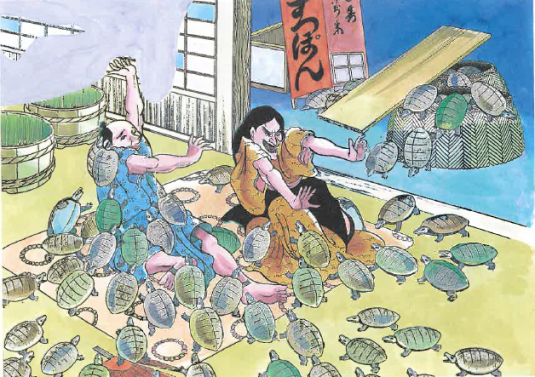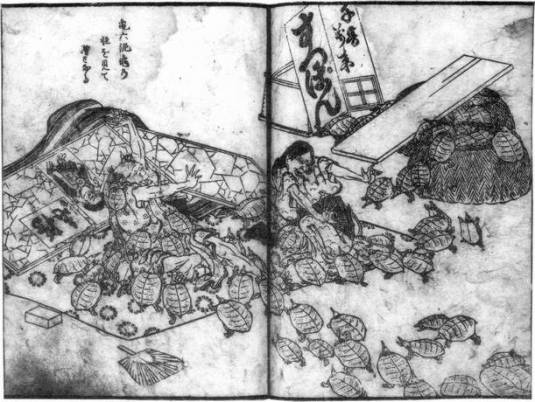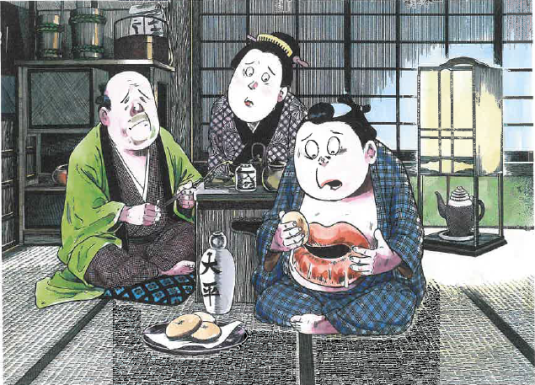Translated and adapted from Mizuki Shigeru’s Mujyara, Ehon Hyakumonogatari, and Japanese Wikipedia
A tale as old as time; in a drunken night of revelry, you climb in bed with a beautiful girl but wake up the next day sleeping besides a giant fat woman. What happened? That hot, sexy gal must have been infected by that insidious yokai disease nebutori – the Sleeping Fatty.
What Does Nebutori Mean?
Nebutori can be written a few ways, all of which are disgusting. The most common is寝肥 which combines 寝 (ne; Sleep) + 肥 (butori; dung, night soil … you know; poop). The term is a play on words, rhyming with 寝太 , meaning寝 (ne; Sleep) + 太 (futori; to gain weight, fat).
Nebutori is a yokai disease. It only infects women, and makes them fat while they sleep–either suddenly or gradually. It is considered an infectious disease, like a bacteria. Women infected with nebutori don’t necessesarily eat more—they just get fat while they sleep. (And yes, it is just women. I have never seen a nebutori tale involving men. Sorry.)
The term has spread into modern Japanese, where it is sometimes used in context to sudden or inexplicable weight gain. Nebutori is also used to describe weight gain in elderly women, especially those on a high-calorie / low-exorcize diet.
Sad Stories of Nebutori
Nebutori originates from the Edo period Ehon Monogatari (絵本百物語; Picture Book of 100 Strange Stories). The story is short and sweet.
A man goes out for a night on the town. After a marathon drinking sessions, he meets and beds a beautiful young girl. They fall asleep next to each other, but in the middle of the night, the man is awoken by a thunderous snore—louder than a passing carriage. He opens his eyes and is shocked to find that—instead of the beautiful girl he went to bed with—he is sleeping next to an enormous mass of quivering flesh.
I found a different story while researching, but I am not sure of its literary origin. It comes from Okushu (modern day Aomori and Iwate prefectures). It doesn’t really seem to describe a case of nebutori—just a woman slowly gaining weight over time—but that is how the tale is listed.
A man and his wife lived together. When they married the wife was slim and beautiful, but she caught nebutori and ballooned in size. The couple owned ten futons, and seven were spread out for the wife to sleep on. Eventually the man became disgusted with this gigantic wife and divorced her. That’s why wives in Okushu are warned to be on the lookout for catching nebutori.
Nebutori and Tanuki Possession
This is an additional tale that is sometimes called nebutori, although in truth it is a case of tanukitsukai—tanuki possession. This story, coming from the 1828 book Shichuso (視聴草; Tales of Looking and Listening).
An elderly woman named Yachi lay on her death bed, breathing her last. To the stunned surprise of her assembled family, Yachi suddenly sprang up and declared herself healthy, but starving. The family brought forth food they had prepared for the funeral service, and the old woman ate it all. But Yachi was still ravenous. While waiting for more food to be prepared, she drank sake and sang boisterous songs. The family was pleased to have Yachi so energetic again, but perplexed. They summoned a doctor to examine her.
The doctor could find nothing wrong with Yachi. Meanwhile, her body was swelling to enormous proportions and she soon outgrew her clothes. The family dug out the winter clothes to try and drape around her, and as they took away her light summer kimono they noticed something strange—the inside was covered in the hair of some kind of beast. The family grew suspicious, and placed a paper and pen next to Yachi asking her to write down her next menu request. With this promptly done, the family knew something was wrong—Yachi could neither read nor write.
That night, the family secretly moved an image of the Amidha Buddha into Yachi’s room. With that done, they saw a shocked tanuki crawl from Yachi’s mouth and flee into the night, leaving behind the dead body it had occupied for awhile.
Translator’s Note:
Is anyone feeling like they caught a case of nebutori after Thanksgiving? Although nebutori isn’t really from overeating—it is more like the yokai equivalent of beer goggles. A drunken guy goes to bed with a hotty and wakes up with a notty. It couldn’t have been a drunken mistake, right? Best to blame it on a yokai disease!
Nebutori is another example that shows just how wide the definition of “yokai” can be. There is no creature here, no monster. Just a “yokai disease” that infects ordinary people.
Further Reading:
For more Thanksgiving-inspired tales of overeating yokai, check out:
Suppon no Onryo – The Vengeful Ghosts of the Turtles












Recent Comments